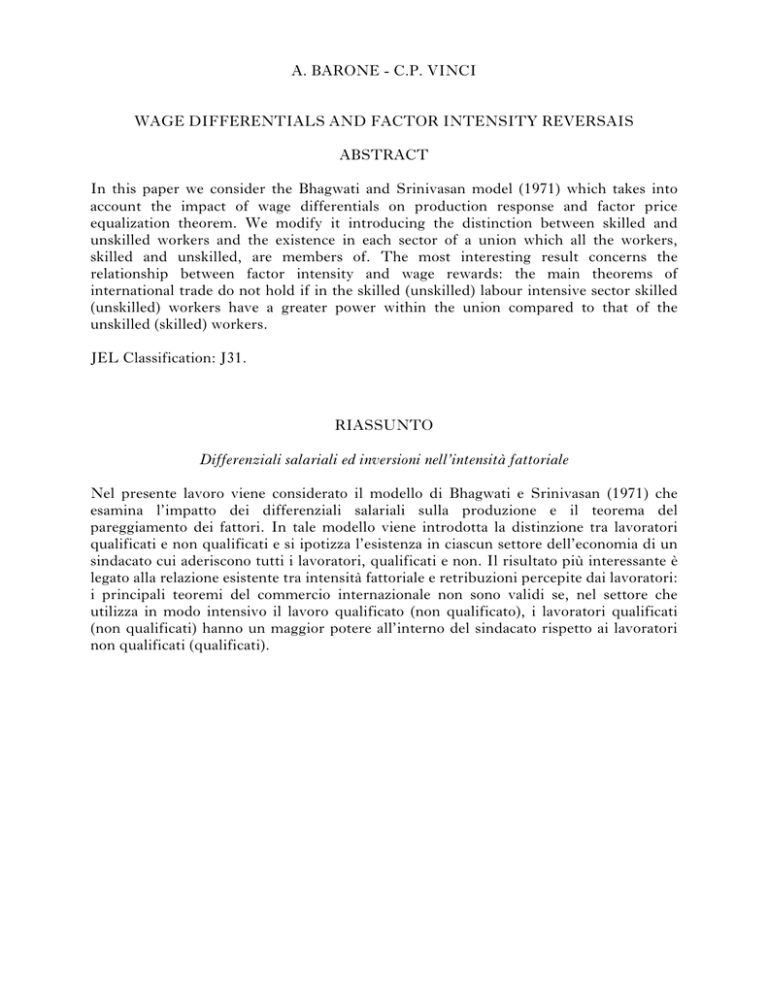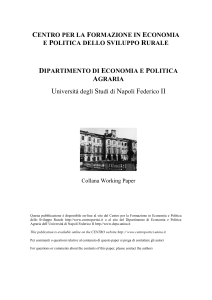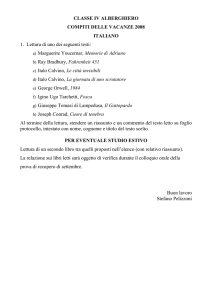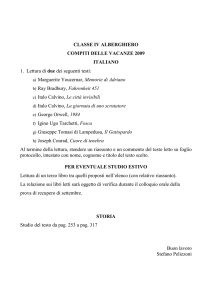
A. BARONE - C.P. VINCI
WAGE DIFFERENTIALS AND FACTOR INTENSITY REVERSAIS
ABSTRACT
In this paper we consider the Bhagwati and Srinivasan model (1971) which takes into
account the impact of wage differentials on production response and factor price
equalization theorem. We modify it introducing the distinction between skilled and
unskilled workers and the existence in each sector of a union which all the workers,
skilled and unskilled, are members of. The most interesting result concerns the
relationship between factor intensity and wage rewards: the main theorems of
international trade do not hold if in the skilled (unskilled) labour intensive sector skilled
(unskilled) workers have a greater power within the union compared to that of the
unskilled (skilled) workers.
JEL Classification: J31.
RIASSUNTO
Differenziali salariali ed inversioni nell’intensità fattoriale
Nel presente lavoro viene considerato il modello di Bhagwati e Srinivasan (1971) che
esamina l’impatto dei differenziali salariali sulla produzione e il teorema del
pareggiamento dei fattori. In tale modello viene introdotta la distinzione tra lavoratori
qualificati e non qualificati e si ipotizza l’esistenza in ciascun settore dell’economia di un
sindacato cui aderiscono tutti i lavoratori, qualificati e non. Il risultato più interessante è
legato alla relazione esistente tra intensità fattoriale e retribuzioni percepite dai lavoratori:
i principali teoremi del commercio internazionale non sono validi se, nel settore che
utilizza in modo intensivo il lavoro qualificato (non qualificato), i lavoratori qualificati
(non qualificati) hanno un maggior potere all’interno del sindacato rispetto ai lavoratori
non qualificati (qualificati).
Y. GEYIKDAGI - N.V. GEYIKDAGI
TOURISM AS A STABILIZER OF FOREIGN CURRENCY RECEIPTS: AN
APPLICATION TO THE MEDITERRANEAN COUNTRIES
ABSTRACT
This paper aims at examining merchandise exports and tourism receipts growths for
twelve Mediterranean countries during the 1982-1994 period and seeing if the interaction
of both can contribute to the stabilization of foreign currency receipts.
The Markowitz portfolio investment model has been used to measure the instability or
fluctuations of both export and tourism earnings taken together by combining the
weighted variances of exports receipts as well as the covariance between the two.
The results of the test show that, for the majority of the Mediterranean countries,
tourism did indeed play a stabilizing role in the flow of foreign currency receipts. The
stabilizing effect was most pronounced in countries where the correlation coefficient
between export and tourism growth rates was negative. With the optimal theoretical
weights for exports and tourism, which were calculated for each country, it was shown
that fluctuations in foreign currency income could be reduced even
L Classification: F14.
RIASSUNTO
Il ruolo del turismo nella stabilizzazione delle entrate valutarie:
una applicazione ai paesi mediterranei
In questo lavoro viene esaminata la crescita delle entrate valutarie per esportazioni1di
beni e di quelle derivanti dal turismo in dodici paesi dell’area del Mediterraneo nel
periodo 1982-1994 per verificare se la loro interazione può contribuire alla stabilizzazione
delle entrate valutarie complessive.
Viene utilizzato il modello di portafoglio di Markowitz per misurare l’instabilità delle
fluttuazioni delle entrate derivanti sia dalle esportazioni che dal turismo mando le
varianze ponderate e considerando anche la covarianza tra i due tipi roventi. I risultati
della verifica indicano che, per la maggioranza dei paesi mediterranei, il turismo ha avuto
un ruolo stabilizzatore per le entrate valutarie. fetto stabilizzante è stato più pronunciato
in quei paesi in cui il coefficiente di corre1azione tra i tassi di crescita delle esportazioni e
del turismo era negativo. Vengono calcolati per ciascun paese i pesi teorici ottimali per
esportazioni e turismo sulla base dei quali si dimostra che le fluttuazioni delle entrate
valutarie potrebbero essere ulteriormente ridotte.
K. GHALI - E AL - SHAMSI
FISCAL POLICY AND ECONOMIC GROWTH: A STUDY RELATING
TO THE UNITED ARAB EMIRATES
ABSTRACT
The aim of this paper is to study and hence establish stylized facts for the effects of fiscal
policy on long-run economic growth for the small oil producing economy of the United
Arab Emirates. Using multivariate cointegration techniques, this is done by
decomposing total government spending into investment and consumption expenditures
and assessing their intertemporal causal effects on output growth. Robust evidence from
the analysis shows that government investment has a positive and significant effect on
growth, while the effect of government consumption is negative and insignificant. Since
in recent years the United Arab Emirates’ government is facing a substantially growing
budget deficit, the paper recommends reducing the share of government consumption
expenditures.
JEL Classification: E62.
RIASSUNTO
Politica fiscale e crescita economica: uno studio riguardante gli Emirati Arabi Uniti
Vengono esaminati gli effetti della politica fiscale sulla crescita economica a lungo
termine in una “piccola economia” produttrice di petrolio, gli Emirati Arabi Uniti. Il
totale della spesa pubblica viene scomposto in spese per investimenti e per consumi e
vengono impiegate tecniche di cointegrazione multivariata per valutarne gli effetti causali
intertemporali sulla crescita del prodotto. I risultati dell’analisi dimostrano che gli
investimenti pubblici hanno un considerevole effetto positivo sulla crescita mentre
l’effetto dei consumi pubblici è negativo e irrilevante. In considerazione del crescente
disavanzo pubblico registrato negli Emirati Arabi Uniti negli ultimi anni, gli autori
suggeriscono di ridurre la quota del consumo pubblico.
M. GIANNETTI
TEORIA DELLE TARGET ZONES: UN’ANALISI FORMALE
DEI CONTRIBUTI RECENTI
RIASSUNTO
La letteratura sulle target zones ha visto la sua nascita alla fine degli anni 80 in seguito a
due successivi articoli di Krugman (1987, 1988). Si è poi sviluppata in due fasi
successive: in una prima fase, seguendo lo schema originale di Krugmari, tutti i modelli
assumevano perfetta credibilità e assenza di interventi intramarginali da parte delle
autorità monetarie. In una seconda fase, invece, data la non rispondenza dei dati alle
proprietà statistiche che ci si aspettava dai modelli di target zone, si è sviluppato un
secondo filone di articoli nei quali si introducevano sia l’ipotesi di non perfetta credibilità
sia la possibilità di interventi intramarginali. Si è ottenuto così una maggiore rispondenza
dei modelli con i dati provenienti dall’EMS.
Tutti gli articoli utilizzano concetti matematici e statistici avanzati, dando spesso per
scontati taluni risultati. Con questo lavoro si è inteso realizzare una rassegna aggiornata
della letteratura sulle target zones e contemporaneamente, esplicitando i passaggi
matematici più complessi, creare uno strumento che rendesse accessibile tale letteratura
anche a chi non abbia una profonda dimestichezza con la matematica.
ABSTRACT
Target Zones Theory: a Formal Analysis of the Most Recent Contributions
The target zones literature has developed extensively after the seminal papers by
Krugman (1987, 1988). The literature has followed two waves: in the first wave,
following the original Krugman model, all the articles assumed a perfectly credible target
zone and the absence of intramarginal interventions. In the second wave, after much
empirical work had shown the faillure of the model to fit the EMS\ data, a new strand of
literature has come to life taking into account a non perfect credibility assumption and
the possibility of intramarginal interventions. Almost all the articles use advanced
mathematical and statistical tools. In addition many of the papers lack an intuitive
explanation and fail to provide the workings from fundamental equations to important
results.
In this paper the aim has been to provide an updated review of the literature and, by
making explicit the most complex passages, create a useful tool to readers that are not
experts in mathemathics.
JEL Classification: F31, F33.
T. GRIES - S. JUNGBLUT
CATCHING UP AND STRUCTURAL CHANGE
ABSTRACT
In this paper we analyze the dynamics of catching up for a backward three sector
economy and investigate the transitional structural adjustment process. A theoretical
model is developed to explain international development and trade patterns as a
transitory process of technological catching up. The endogenous adoption of
international available technologies will cause permanent structural adjustment for a non
symmetric sectoral diffusion of international technologies. The model is individually
tested for 146 countries. The estimations support the implied s-shaped path of upgrading
for a large number of countries. The estimation results are used to calculate the speed of
convergence and the final income position for each of the 146 countries.
JEL-Classification: F11, F21, F22, 041
RIASSUNTO
Processo di convergenza e cambiamento strutturale
Il lavoro analizza la dinamica di catching up in una economia tecnologicamente arretrata
a tre settori e studia il processo di adeguamento strutturale nella fase di transizione.
Viene costruito un modello di sviluppo internazionale e di commercio internazionale
come processo di catching up tecnologico. L’adozione di tecnologie disponibili a livello
internazionale determina un aggiustamento strutturale permanente a causa della
diffusione settoriale non simmetrica delle tecnologie internazionali. Il modello viene
sottoposto a verifica per 146 paesi. Le stime indicano un andamento a s del progresso
tecnico per numerosi paesi. I risultati delle stime vengono utilizzati per calcolare la
velocità della convergenza e la posizione finale in termini di reddito per ciascuno dei 146
paesi considerati.
C. IMBRIANI - E RECANATI
SPILLOVERS INTERNAZIONALI DI EFFICIENZA NEL SETTORE
MANIFATTURIERO ITALIANO
RIASSUNTO
Questo lavoro esamina le principali interpretazioni teoriche ed empiriche concernenti gli
effetti degli investimenti diretti esteri sulla efficienza delle imprese locali ed, in
particolare, in che modo gli spillovers di efficienza si collegano alla dimensione del gap
tecnologico esistente tra imprese locali ed affiliate estere. Esso inoltre, prendendo in
considerazione il settore manifatturiero italiano ed usando dati cross-section, giunge alla
conclusione che, se da un lato la presenza di imprese estere ha un effetto positivo sul
livello di efficienza delle imprese italiane, dall’altro gli spillovers di efficienza sono
maggiori in quelle industrie dove minore è la dimensione del gap tecnologico tra imprese
italiane ed imprese estere.
ABSTRACT
International efficiency spillovers into the Italian manufacturing sector
This paper examines the main theoretical and empirical interpretations regarding the
effects of foreign direct investment on technical efficiency of local firms and, in
particular, in which way technical efficiency spillovers relate to the size of the technology
gap between domestically-owned firms and foreign firms. By taking into account the
Italian manufacturing sector and using cross-sectional data, we find that productivity
levels are higher in the domestic sectors where multinational firms account far larger
shares and that efficiency spillovers are higher the lower the size of the technology gap
between domestic and foreign firms.
JEL Classification: F23; O30.
PC. PADOAN
GLOBALIZATION AND EUROPEAN REGIONAL INTEGRATION
ABSTRACT
The two main current trends in the world economy are regionalism and globalization. It
remains still largely unclear, however, how these two trends interact and what the
implications of such an interaction for the world economy are. In this paper I consider
one aspect of the interaction among the two trends: whether increased globalization will
favor a more “open” regionalism, i.e. a tendency towards the progressive enlargement of
regional agreements to outsiders. Discussion relates to the European experience.
The relationship between globalization and regionalism presents both a deepening and a
widening dimension. It is considered why globalization should influence the process of
regional widening by fostering a process of convergence among countries participating in
a regional trade agreement. The analysis of the European experience is carried out by
looking at the evolution of FDI activities, international mergers and acquisitions and
FDI specialization in Europe over the period following the announcement the Single
European 1\’Iarket as well as at the characteristics of a number of industrial sectors
where multinational activities are particularly relevant. The relationship between trade
specialization and investment specialization in the four largest European economies
(Germany, France, Italy and the UK) is then considered. Finally we consider the
experience of four “peripheral members” of the EU (Greece, Ireland, Portugal and
Spain) from the point of view of trade specialization and FDI inflows and we discuss the
perspectives of future EU enlargements.
JEL Classification: F15, F23, L60.
RIASSUNTO
Globalizzazione ed integrazione regionale europea
I rapporti tra regionalismo e globalizzazione nell’economia internazionale sono tuttora in
gran parte poco chiari. In questo lavoro si affronta un aspetto di tali rapporti, e in
particolare se la globalizzazione, intesa come crescente diffusione degli investimenti
diretti, conduca verso forme di regionalismo “aperto”, cioè favorisca l’allargamento a
paesi non membri degli accordi regionali. Si prende in esame il caso dell’integrazione
regionale europea considerando la relazione tra specializzazione commerciale e
andamento degli investimenti diretti nei principali paesi “centrali” e nei membri “
periferici” dell’unione europea. Ne emergono sia fenomeni di polarizzazione che di
diffusione dei modelli di specializzazione.
A. RUOCCO - W WIEGARD
IL DISAVANZO PUBBLICO NELL’UNIONE EUROPEA: QUANTO SONO
IMPORTANTI I CRITERI DI CONVERGENZA?
RIASSUNTO
In questo lavoro ci siamo concentrati su quanto siano rilevanti i criteri di convergenza
relativi alle politiche di bilancio stabiliti dal Trattato di Maastricht per l’ammissione
all’Unione monetaria. In particolare, la discussione si è concentrata sul problema se sia
più importante rispettare i termini previsti per l’inizio della terza fase dell’Unione
monetaria, piuttosto che esigere uno stretto soddisfacimento dei criteri di convergenza.
Nel corso dell’ultimo anno tutti gli Stati membri, fatta eccezione per la Grecia, hanno
ottenuto ottimi risultati con riguardo a tutti i parametri fissati dal Trattato all’infuori di
quelli inerenti al consolidamento delle finanze pubbliche. Ci siamo quindi concentrati su
alcuni punti chiave: in che senso si possono giustificare economicamente i limiti di
indebitamento armonizzati sanciti dal Trattato? Che relazione esiste tra queste
giustificazioni e la creazione di una Unione monetaria? In breve, la ragione più plausibile
per porre dei limiti all’indebolimento è la presenza nelle democrazie parlamentari di forti
incentivi per le spese in disavanzo e la conseguente indesiderabile redistribuzione
intergenerazionale a danno delle generazioni future. Queste motivazioni hanno, però,
poco a che spartire con la creazione di una Unione monetaria. L’aver fissato dei valori di
riferimento ha, comunque, esercitato un grande stimolo al processo di consolidamento
delle finanze pubbliche di tutti gli Stati membri, che difficilmente avrebbe avuto luogo
altrimenti. In questo senso si dovrebbe propendere per una interpretazione generosa dei
parametri, comunque in linea con lo spirito della norma del Trattato e fare quindi partire
la terza fase dell’Unione monetaria il i gennaio 1999, con la partecipazione di tutti gli
Stati membri ad eccezione fatta per la Grecia.
ABSTRACT
Government deficit in the European Union:
How important are convergence criteria?
This paper is concerned with the question as to whether or not the deficit criteria of the
Maastricht Treaty are a necessary precondition for entry into the monetary union. More
specifically, the discussion is reduced to whether or not adhering to the timetable is more
important than the strict fulfillment of the convergence criteria themselves while all the
member countries except Greece have been successful in controlling inflation, exchange
rate stability and the convergence of long—term interest rates, in the area of budgetary
consolidation further improvements are still required. This is the reason why have
restrict ourselves to providing answers to the following questions: are harmonized deficit
restrictions economically justifiable? What relationship exists between these justifications
and the establishment of a monetary union? In summary, the main convincing reason for
the establishment of borrowing limits is the excessive borrowing incentive inherent to
parliamentary democracies and the resulting undesirable intergenerational redistribution
at the expense of future generations. But these reasons are completely independent of the
creation of a monetary union. ‘The politically defined reference values for the deficit
criteria have caused great consolidation efforts in all member countries of the European
Union, which were hardly considered possible. In this light there is much reason to
support the adherence to the time schedule and a generous interpretation of the budget
policy values, which would be still in accordance with the Maastricht Treaty The
monetary union could then begin on January 1, 1999, including all member states except
Greece.
JEL Classification: H62, F33.










